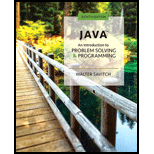
Explanation of Solution
a.
Method heading for each method:
- • Method heading for read rating from user is “public void readRating()”.
- • Method heading for gets maximum rating is “public int getMaximumRating()”...
Explanation of Solution
b.
Preconditions and postconditions of each method:
- • Precondition and postcondition of “public void readRating()” method.
- ○ Precondition: Display maximum rating range for given description using object of “RatingScore” class.
- ○ Postcondition: The “the_rating” is assigned to “value”.
- • Precondition and postcondition of “getMaximumRating()” method.
- ○ Precondition: None...
Explanation of Solution
c.
Test class for some Java statement:
//Create object "movieScore" from "RatingScore" class
RatingScore movieScore = new RatingScore();
//Create object "restaurantScore" from "RatingScore" class
RatingScore restaurantScore = new RatingScore();
//Call "setRatingScore" method for object "movieScore"
movieScore.setRatingScore("Merry's excellent movie", 8);
//Call "setRatingScore" method for object "restaurantScore"
restaurantScore.setRatingScore("Food quality", 20);
//Read rating for object "movieScore" by calling the method "readRating".
movieScore.readRating();
//Display the given statement
System...
Explanation of Solution
d.
Implementation of class:
RatingScore.java:
//Import package
import java.util.Scanner;
//Define a class "RatingScore"
public class RatingScore
{
//Declare required instance variable
private String desc;
private int maximum_rating;
private int the_rating;
//Set values to "RatingScore" attributes
public void setRatingScore(String d, int m)
{
desc = d;
maximum_rating = m;
the_rating = -1;
}
//Method definition for read rating from user
public void readRating()
{
//Display given statement for description
System.out.println("Enter rating for " + desc + ":");
//Display given maximum rating
System.out.println("Please enter an integer from 0 to " + maximum_rating);
//Create object for Scanner class
Scanner r = new Scanner(System.in);
//Assign "value" to "-1"
int value = -1;
//Assign required rating to "true"
boolean requiredRating = true;
//Check rating condition using "while" loop
while(requiredRating)
{
//Read input from user
value = r.nextInt();
if(value >= 0 && value <= maximum_rating)
{
requiredRating = false;
}
else
{
System.out.println("Error: The given rating is out of range.");
System.out.println("Enter an integer from 0 to " + maximum_rating);
}
}
the_rating = value;
}
//Method definition for gets maximum rating
public int getMaximumRating()
{
//Returns maximum rating
return maximum_rating;
}
//Method definition for gets rating
public int getRatingValue()
{
Want to see the full answer?
Check out a sample textbook solution
Chapter 5 Solutions
Java: An Introduction To Problem Solving And Programming Plus Mylab Programming With Pearson Etext -- Access Card Package (8th Edition)
- "Do not use AI tools. Solve the problem by hand on paper only and upload a photo of your handwritten solution."arrow_forward"Do not use AI tools. Solve the problem by hand on paper only and upload a photo of your handwritten solution."arrow_forward"Do not use AI tools. Solve the problem by hand on paper only and upload a photo of your handwritten solution."arrow_forward
- "Do not use AI tools. Solve the problem by hand on paper only and upload a photo of your handwritten solution."arrow_forwardSolve this "Do not use AI tools. Solve the problem by hand on paper only and upload a photo of your handwritten solution."arrow_forward"Do not use AI tools. Solve the problem by hand on paper only and upload a photo of your handwritten solution."arrow_forward
- "Do not use AI tools. Solve the problem by hand on paper only and upload a photo of your handwritten solution."arrow_forwardSpecifications: Part-1Part-1: DescriptionIn this part of the lab you will build a single operation ALU. This ALU will implement a bitwise left rotation. Forthis lab assignment you are not allowed to use Digital's Arithmetic components.IF YOU ARE FOUND USING THEM, YOU WILL RECEIVE A ZERO FOR LAB2!The ALU you will be implementing consists of two 4-bit inputs (named inA and inB) and one 4-bit output (named out). Your ALU must rotate the bits in inA by the amount given by inB (i.e. 0-15).Part-1: User InterfaceYou are provided an interface file lab2_part1.dig; start Part-1 from this file.NOTE: You are not permitted to edit the content inside the dotted lines rectangle. Part-1: ExampleIn the figure above, the input values that we have selected to test are inA = {inA_3, inA_2, inA_1, inA_0} = {0, 1, 0,0} and inB = {inB_3, inB_2, inB_1, inB_0} = {0, 0, 1, 0}. Therefore, we must rotate the bus 0100 bitwise left by00102, or 2 in base 10, to get {0, 0, 0, 1}. Please note that a rotation left is…arrow_forwardSolve this "Do not use AI tools. Solve the problem by hand on paper only and upload a photo of your handwritten solution."arrow_forward
- Solve this "Do not use AI tools. Solve the problem by hand on paper only and upload a photo of your handwritten solution."arrow_forward"Do not use AI tools. Solve the problem by hand on paper only and upload a photo of your handwritten solution."arrow_forwardSolve this "Do not use AI tools. Solve the problem by hand on paper only and upload a photo of your handwritten solution."arrow_forward
- Programming Logic & Design ComprehensiveComputer ScienceISBN:9781337669405Author:FARRELLPublisher:Cengage
 EBK JAVA PROGRAMMINGComputer ScienceISBN:9781337671385Author:FARRELLPublisher:CENGAGE LEARNING - CONSIGNMENT
EBK JAVA PROGRAMMINGComputer ScienceISBN:9781337671385Author:FARRELLPublisher:CENGAGE LEARNING - CONSIGNMENT EBK JAVA PROGRAMMINGComputer ScienceISBN:9781305480537Author:FARRELLPublisher:CENGAGE LEARNING - CONSIGNMENT
EBK JAVA PROGRAMMINGComputer ScienceISBN:9781305480537Author:FARRELLPublisher:CENGAGE LEARNING - CONSIGNMENT  Microsoft Visual C#Computer ScienceISBN:9781337102100Author:Joyce, Farrell.Publisher:Cengage Learning,
Microsoft Visual C#Computer ScienceISBN:9781337102100Author:Joyce, Farrell.Publisher:Cengage Learning, C++ Programming: From Problem Analysis to Program...Computer ScienceISBN:9781337102087Author:D. S. MalikPublisher:Cengage Learning
C++ Programming: From Problem Analysis to Program...Computer ScienceISBN:9781337102087Author:D. S. MalikPublisher:Cengage Learning Programming with Microsoft Visual Basic 2017Computer ScienceISBN:9781337102124Author:Diane ZakPublisher:Cengage Learning
Programming with Microsoft Visual Basic 2017Computer ScienceISBN:9781337102124Author:Diane ZakPublisher:Cengage Learning





